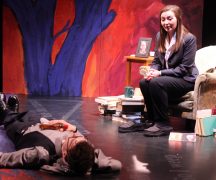By DAVID DUPONT
BG Independent News
The last day of classes this spring semester will mark the end of the 42-year history of the Lillian and Dorothy Gish Film Theater in Hanna Hall.
Bowling Green State University officials hope this will mark a new chapter in film studies at the university, though the man behind the theater, Ralph Haven Wolfe remains disheartened at the changes to the theater he founded and led for 40 years.
He said Friday afternoon that changing the theater in the Bowen Thompson Student Union into the Gish marks a step back to 1975 when the university did not have a theater dedicated to showing films.
The space in the union will still be a multi-use space, he said.
That’s necessary said, Dean Ray Craig, who led several members of the media on a tour Friday of where the Gish facilities will be moving next semester.
Those include a large lecture hall, Olscamp 117, which will be named the Ralph Haven Wolfe Viewing Center.
That will replace in name the viewing center now in Hanna. That viewing room houses a collection of hundreds of videocassettes, DVDs, and laserdiscs donated to BGSU by Wolfe.
The relocation project will cost $500,000, said Bruce Meyer, interim vice president for capital planning/campus operations. The money will come from funds allocated to complete the university’s master plan.
Craig explained that the Gish has served two communities. There are the students in film studies who screened their original work in the 168-seat venue, and there were film series that attracted the broader community. Those were the Sunday matinees, often silent films with live musical accompaniment, a Tuesday film series, and international films on Thursdays.
Those series will all move to the student union theater.
That auditorium will get a new digital high definition projection system and a screen large enough for those images. The sound system will be rearranged with some of the speakers now lining the walls being placed behind the screen.
The system, said Bob Waddle, assistant vice president for capital planning, will be the same system used throughout campus, and that should avoid the glitches that sometimes have occurred during presentations in the venue. Now if there is a problem, any campus technician should be able to fix it.
Craig said that though film programming will take priority, the auditorium will still need to be used for other events.
There will be some interior improvements, including new carpeting.
The seats from the Gish with name plates honoring donors will not be used. Waddle explained that seats in a theater must conform to the slope of the theater floor.
The lobby will house rotating displays of Gish memorabilia. Craig said some of the enlarged movie stills that were given to BGSU after an exhibit honoring the Gishes at the Museum of Modern Arts may be used outside the theater as well.
“We’re still recognizing the lasting legacy of the Gish Theater,” Craig said.
Items not displayed are kept in the archives at Jerome Library and in the remote storage facility at Levis Commons. Some may also be loaned to the Wood County Historical Center. The Gish sisters, Ohio natives, made their stage debuts in Risingsun.
The material from the Wolfe Viewing Center in Hanna will be given to the library. Some will end up at the Department of Theatre and Film. Any of particular interest will be digitized, Craig said, “to make sure we keep the collection but in the appropriate format.”
The Olscamp space will require more work. Not only will it get the same HD projection system and larger screen, but it will need paneling to dampen the hall’s echo.
The seating will remain the same, with chairs and tables. Among its uses will be the Intro to Film course taken by hundreds of non-majors. Also, it will be used by other courses that screen films.
Craig said some changes will be made to give the space the “art house” feel that students would like.
He noted that when the closing of the Gish in Hanna was announced most of the concern came from the community. Lately it has been film students expressing concern.
This weekend the University Film Organization/BG Reel will hold the BGSU Film and Media Festival for the last time in the Gish and will honor Wolfe in ceremonies at 5:30 p.m. Sunday.
Craig said there are now 160 majors in either film studies or film production. The program is growing both in reputation and in the number of students enrolled.
The films of Professor Thomas Castillo and the books by Professor Cynthia Baron have helped it gained prominence as have the careers of graduates, such as Jay Ellison, founder of Shawdowcast Pictures in California.
BGSU’s brightest Hollywood star Eva Marie Saint weighed in on the Gish relocation during her visit to campus last week. While paying tribute to Wolfe’s dedication to keeping alive the memory of the Gish sisters through the theater, she said times change, and “we have to accept that.”
Wolfe “put his heart and soul” into the Gish, Craig said
Still the professor emeritus remains unsatisfied. “Aesthetically I do not think the theater in the union is appropriate as the first lady of American film,” Wolfe said.
He recalls when films were first shown in Hanna Hall in 1975, in the auditorium of the school the College of Education ran in the building. He envisioned a theater, which was completed in 1976.
He approached Lillian Gish about coming to BGSU to have the theater named for her. She said she’d come if the theater was dedicated to her sister, Dorothy, as well. Gish visited the theater several times, as did Saint, who at the beginning of her career worked with Gish.
Wolfe said the move is an injustice to all those who contributed to developing the venue. He said the problem was that the university could not raise enough money for a new building as the home of the College of Business, and decided instead to renovate and add onto Hanna Hall, which will become the Maurer Center.
Still retaining the film theater there would not be incongruous given the size of the film industry.
“I think President (Rodney) Rogers and Dean Craig are trying to make the best of the situation that was handed to them,” he said.
Craig said that the new facilities will give greater visibility to the film program with theaters in Olscamp, a major classroom building, and the student union.
These changes, he said, will represent “a significant upgrade” for a program the university looks to expand.





